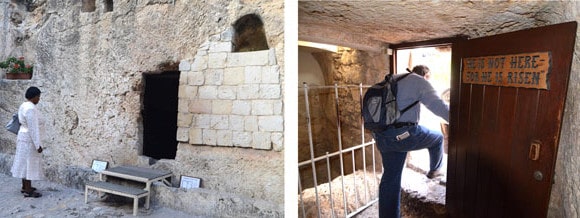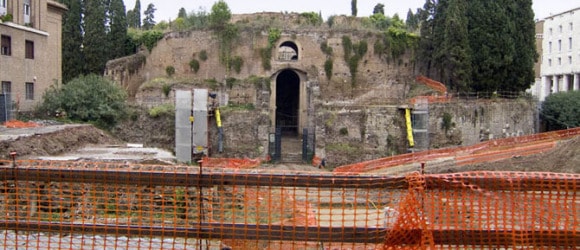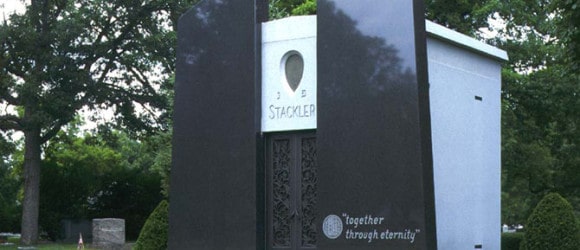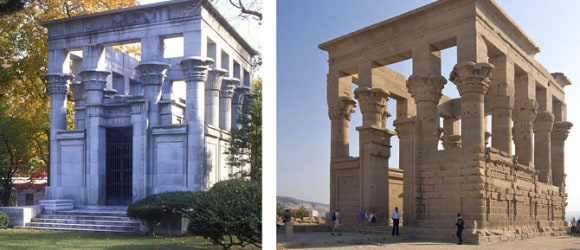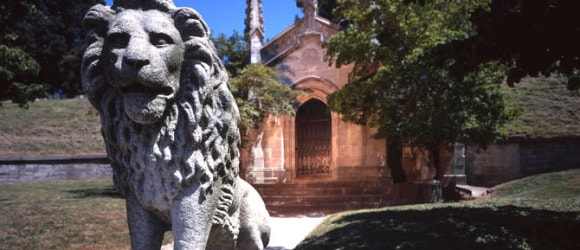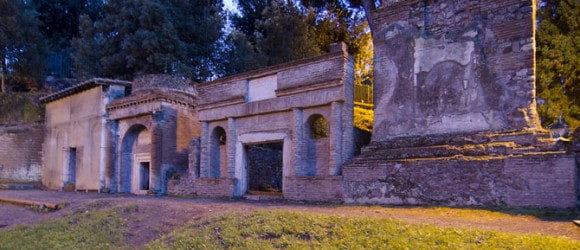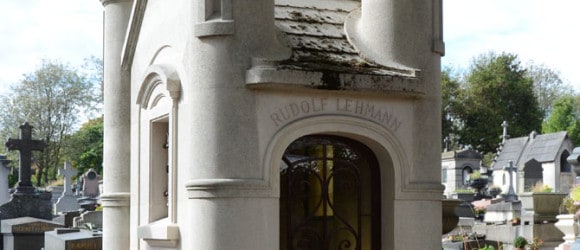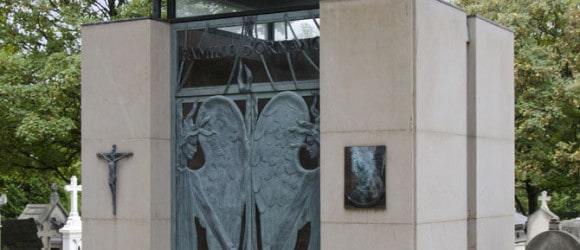The Taj Mahal: A Tomb For Two For Love
- At August 12, 2013
- By mausoleum
- In Doug Keister's Blog
0
We’ve all heard the line before: You’ve gotta go see a certain movie, a tourist site, a cathedral, a … well… insert whatever it may be. What often happens? You see/hear/experience whatever it may be, and you think, “Well that was nice, but it didn’t really knock my socks off.” I think I’d rather hear from someone, “Hey, why don’t you check out (insert item here), I think you might like it.” Then at least my expectations aren’t too high.
However, if you ever get a chance to see the Taj Mahal in person, go! It is truly SPECTACULAR. Not only is it one of the most recognizable buildings in the world, it is also a mausoleum. A tomb built for two.
Read More»In Search of Jesus’ Tomb
- At August 16, 2013
- By mausoleum
- In Doug Keister's Blog
0
It is probably next to impossible to precisely plumb what tomb people most want to see. The Taj Mahal and the Great Pyramid of Giza are certainly contenders. But the majority of people do not go to those places because they want to see a tomb. They go there because of the history and architecture.
However, there is one burial place where people go specifically to see a tomb. The name of the person who supposedly occupied this tomb just might be the most recognizable name on Earth: Jesus of Nazareth.
Travelers to the Holy Land often hear the phrase ‘the tradition is.’ There are so many layers of history, buildings, events, and people that the whereabouts of specific historic sites have been lost to the ages. To be sure, the Mount of Olives, Garden of Gethsemane, the Sea of Galilee, the Jordan River, and Mount Zion are verifiable places. But other places are often referred to as the ‘traditional site’ such as the traditional site of the Last Supper and the traditional site of Jesus’ birth. Other sites have more than one traditional location. Such is the case with Mary’s place of ascension and Jesus’ tomb and place of ascension.
Read More»2000 Year Old Mausoleum to Receive $3 Million for Restoration in Creative Trade
- At October 23, 2014
- By mausoleum
- In Doug Keister's Blog
0
I can’t count the number of times that, when I tell people about my appreciation of mausoleums and cemeteries, I hear, “What a waste of money. What are they good for? People ought to be assigning money in their wills toward art and things that benefit humanity.”
After they have finished their all-things-funerary diatribe, I pause to collect my thoughts. Then, with one eye closed and eyebrow raised, I ask them what they think about the Pyramids of Egypt, the Taj Mahal in India, the Terra-cotta Warriors in China, Westminster Abbey in England, and the Pantheon in Rome.
As I continue to rattle off well-known mausoleums and burial locations around the world, they usually hold up their hand imploring me to stop. They get my point. The fact is many of the most popular tourist destinations in the world are mausoleums. They are not only a testament to the entombed person but timestamps that often tell us, in great detail, what the architectural and social mores were at the time they were constructed.
The latest permutation of the staying power of mausoleums is that one of them has now become a bargaining chip: the restoration of the Mausoleum of Augustus in Rome for art. Augustus was the first emperor of Rome. He ruled as emperor for 41 years, dying at age 75 in 14 AD.
Read More»The Mausoleum Enters the Twenty First Century
- At March 27, 2013
- By Doug Keister
- In Doug Keister's Blog
0
When I first began photographing mausoleums for my book Going Out in Style: The Architecture of Eternity in 1997, my primary focus was documenting historic mausoleums, mostly from the late nineteenth century. After all, my background was in photographing historic architecture (mostly Victorian and Arts and Crafts homes). Mausoleums were simply another type of historic residential architecture.
Almost every architectural or design style eventually makes it into the cemetery. When Napoleon invaded Egypt with both soldiers and artists, it triggered a phenomenon that became known as Egyptian Revival architecture thanks mostly to a French book of drawings by Napoleon’s artists, Description de l’Égypte, published in 1809. Egyptian Revival was, of course, the perfect architectural style for cemeteries and mausoleums since almost all Egyptian architecture had something to do with death and the afterlife.
The same can be said for Gothic Revival churches, Greek temples, and Art Deco theaters. All of those styles eventually made it into the cemetery in the form of mausoleums and other monuments.
Read More»Seeing Double: Bache Mausoleum borrows from Kiosk of Trajan
To coin a phrase, “if it works, don’t fix it.” The design of most mausoleums, like houses, is based on tried and true templates. And there are, of course, personal visions, one-of-a-kind mausoleums, that reflect the taste or whim of the designer or owner. There is a third inspiration for mausoleums: basing the design on existing buildings that may or may not be mausoleums. When designing a mausoleum, it is certainly worth considering using an existing building as inspiration. Indeed, if it works, don’t fix it.
Read More»Accessorize, Accessorize
- At October 25, 2014
- By mausoleum
- In Doug Keister's Blog
0
Although there are a number of architectural and design styles differentiating mausoleums, designers add a little more pizzazz with architectural embellishments and statuary. The statuary can be inside or outside the mausoleum and, unlike mausoleums where granite is the preferred medium, statuary has a wide range of options.
Durable materials such as granite, marble, and bronze all have their attributes for mausoleum design and embellishment. Each material has its own intrinsic appeal, but the choice of material is essentially a matter of personal taste.
Marble, of course, has been long associated with classical ideals. Its inherent translucency exudes a depth not attainable with granite or bronze. It is also softer than granite or bronze and is easier to work with, especially when trying to simulate smooth human skin. But its softness is also a magnet for stains and the ravages of acid rain.
Read More»The City of the Dead in a City of the Dead
- At May 13, 2014
- By mausoleum
- In Doug Keister's Blog
0
Pompeii’s Mausoleums Provide the First Glimpse of the City
Mausoleums make great time capsules, mirroring the styles and traditions of the cultures that create them. Nowhere is that more evident than Pompeii, a city of the dead.
The citizens of Pompeii had plenty of warning signs they were sitting on the edge of the time bomb Mt. Vesuvius. In 62 C.E., a small earthquake rattled the town. Seventeen years later, in 79 C.E., fissures opened and steam poured out of the cracks. A few days later, pent-up gasses exploded, raining down rock and ash all over the city and prompting over 18,000 of Pompeii’s citizens to flee. Fifteen hundred people were left behind — those who either chose to stay or couldn’t escape fast enough. Staying proved to be a fatal error. Every one of the 1500 perished.
The 79 C.E. eruption of Mt. Vesuvius buried Pompeii in a thick layer of volcanic ash (tephra) approximately 75 feet deep and put a timestamp on what life was like in a small Roman town in the autumn of 79. Pompeii became an architectural and historical treasure trove.
Read More»Family Mausoleums Afford Opportunities to Channel Inspiration
- At May 09, 2014
- By mausoleum
- In Doug Keister's Blog
0
“Genius,” Thomas Edison famously said, “is 1% inspiration and 99% perspiration.” That quote is often morphed into success is 1% inspiration and 99% perspiration and the various percentages of inspiration and perspiration have been altered as well. But the message is clear: under the visible tip (inspiration) of the iceberg of invention is an enormous foundation of hard work. While that is almost always true, what history remembers is the final result and not the effort that it took to achieve it.
To be sure, constructing a mausoleum requires substantial amounts of perspiration, not only by those building it, but by the person funding it. But, again, it is the result that is enduring. To coin another famous quote “God is in the detail.” In other words, if you are going to expend a lot of energy and resources, it’s worth taking time to make some inspired choices.
So where does one look for inspiration when designing a mausoleum? Certainly, there are a number of perfectly appropriate mausoleums that come pre-designed. Most of these designs are based on classical architecture principals and have, since the middle of the 18th century, been a staple of most architects’ palettes.
Read More»Getting Out of Your Furnished Rut
- At December 17, 2013
- By mausoleum
- In Doug Keister's Blog
0
All of us get into ruts, whether it’s in our work or our leisure pursuits. There is a certain comfort with the familiar. But sometimes it’s good to explore new terrain and ideas. When contemplating one’s eternal home it might be worth considering the adventurous and unusual rather than just sticking to traditional styles.
When exploring cemeteries and mausoleums, I look for tombs that are a little (and sometime a lot) different. After all, after exploring dozens and dozens of cemeteries around the world, mausoleums, just like there urban counterparts, mansions, start to look alike. I like to add a little visual spice to my diet.
I seek out those seemingly out-of-place tombs and mausoleums and find myself wondering if the quirky architectural embellishments reflect an eccentric individual, or if, perhaps, the person simply wanted to make a special final statement.
What many people don’t know is that building a mausoleum in a unique style often costs little more than building one using a conventional design. All mausoleums share similar elements. They need to have foundations, crypts, doors, and substantial walls. It is just the details that separate the conventional from the unique.
Read More»Exploring New Dimensions
- At December 10, 2013
- By mausoleum
- In Doug Keister's Blog
0
Traveling through the vast fields of mausoleums in large urban cemeteries in places like New York City and Chicago, it is easy to get the impression that all mausoleums are substantial and authoritative structures. To be sure, most mausoleums are built of rather heavyweight materials. After all, they are designed to last for eternity. And eternity does favor the substantial.
Proper building techniques, combined with an adequate perpetual care plan, enable mausoleum architects to explore unique design options and create some very interesting mausoleums. One material most people don’t associate with mausoleums is large expanses of glass.
To be sure, most mausoleums contain some sort of stained glass window, but modern laminated glass manufacturing techniques render glass virtually unbreakable. Designers use various configurations and sizes of glass to creating a feeling of lightness or airiness.
Read More»
